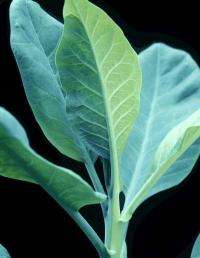Can a single layer of cells control a leaf's size?

Ever looked carefully at the leaves on a plant and noticed their various sizes and shapes? Why are they different? What controls the size and shape of each individual leaf? Very little is known about the developmental control of leaf size and shape, and understanding the mechanisms behind this is a major issue in plant biology.
A leaf's size is determined by a combination of cell number, cell size, and intercellular space. Michael Marcotrigiano from Smith College, Massachusetts, wanted to find out what role cell layers played in regulating leaf size and shape. He utilized a powerful tool—the synthesis of graft chimeras—that has allowed him to carefully analyze the developmental regulation of leaf size and shape in Nicotiana and has published his findings in the February issue of the American Journal of Botany.
By grafting plants of different Nicotiana genotypes Marcotrigiano was able to recover shoots from the graft union that were chimeras. These shoots were composed of both genotypes. Eventually he recovered leaves with two genetically distinct cell layers. He grafted N. tabacum, a large-leaf genotype, and N. glaucum, a small-leaf genotype, to produce leaves where the resulting epidermal cell layer was a different genotype than the mesophyll cell layer—but on only one side of the leaf, allowing for direct comparison of the growth of the leaf from one side to the other. Thus, one side of the leaf could act as a "control" for the other side of the leaf. This enabled him to set up some nicely designed comparisons where on one side of the leaf the outer cell layer (the epidermis) differed in genotype from the rest of the leaf.
"Since leaves generally vary in size along the length of the stem and leaf size is strongly influenced by environmental factors, my method allowed me to compare one side of a leaf to the other, negating the complications that arise when comparing different leaves on a single plant or leaves on different plants," Marcotrigiano said.
Creating these graft chimeras was time-consuming and involved an element of chance; often the growing tip of the chimeral shoots reverted back to a non-chimeral shoot rendering the leaves generated from that point on useless for analysis. However, over the past decade enough leaves were recovered that were perfectly bisected, homogeneous on one side of the midvein and with a unique epidermis on the other. This allowed Marcotrigiano to use them to examine how leaf cell layer affects leaf size and shape.
Marcotrigiano's most striking finding was the important role that the epidermal cells played in determining leaf size. He found that leaves grew asymmetrically when one side of the midvein contained identical cell layer arrangements and the other side contained epidermal cells that differed genetically from the mesophyll cells. When big-leaf epidermal cells surrounded small-leaf mesophyll cells in an otherwise all small-genotype leaf, the big-leaf epidermal cells caused that side of the leaf to be bigger than the other side. In contrast, when small-leaf epidermal cells surrounded big-leaf mesophyll cells in an otherwise all big-genotype leaf, the small-leaf epidermal cells caused that side to be smaller than the other side.
Epidermal cells not only controlled overall leaf size, but also influenced the number of cells produced in the mesophyll layer. For example, small-leaf epidermal cells surrounding big-leaf mesophyll cells caused the mesophyll cells to have many fewer cell divisions than when they were surrounded by big-leaf epidermal cells. Interestingly, the epidermal cells did not influence, or change, the size of the mesophyll cells.
Marcotrigiano concludes that while regulation of leaf size is complex and influenced by many factors and many genes, his findings show that communication between adjacent cell layers plays an important role in determining leaf size. Cells in one tissue layer can control the rate of division of cells in another tissue layer, which in turn influences overall leaf size.
More information: http://www.amjbot.org/cgi/content/full/97/2/224
Provided by American Journal of Botany















